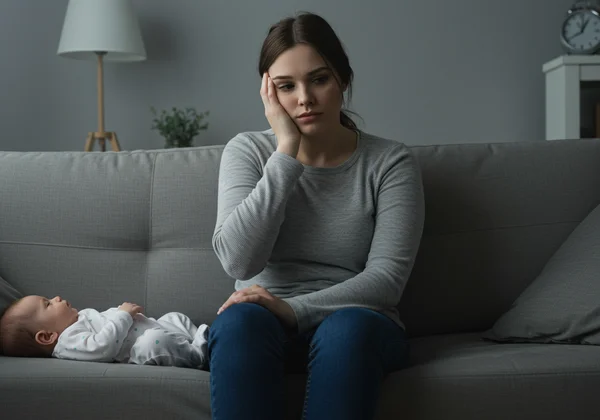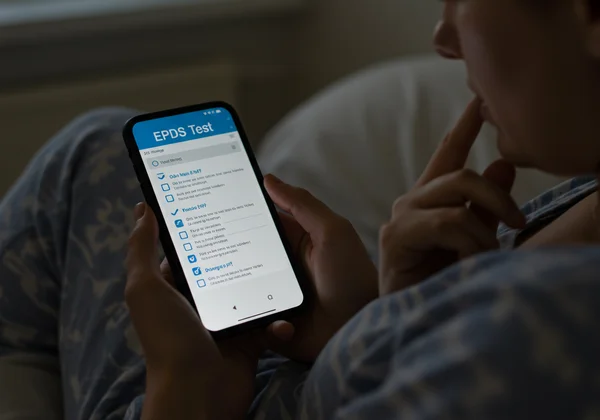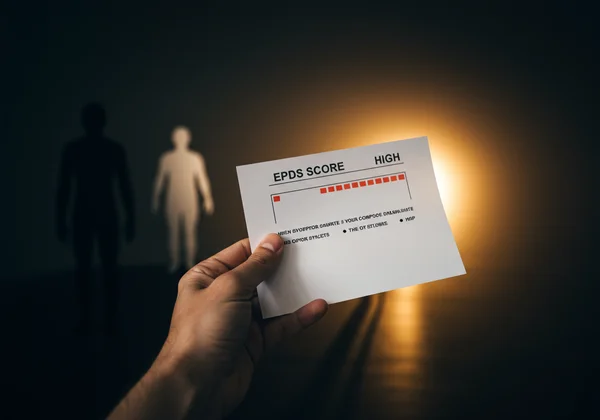My High EPDS Score & Postpartum Depression Recovery Story
The first few weeks with my newborn were a blur of breathtaking love and bone-deep exhaustion. I expected the sleepless nights and the endless cycle of feeding and changing. What I didn't expect was the heavy, gray fog that slowly rolled in and refused to leave. It wasn't just the "baby blues" everyone talked about. This was different. This was my personal story of confronting a high EPDS score and finding my way back to the light. If you're feeling lost in the shadows of motherhood, asking yourself what to do after a high EPDS score?, I hope my journey can offer you a glimmer of hope. Maybe it's time to understand your feelings with a confidential first step, just like I did. You can start your screening right now.

Recognizing the Signs: My Journey to the EPDS Test
Before my baby arrived, I had pictured motherhood as a series of sunny, Instagram-worthy moments. The reality was far more complex. The joy was immense, but it was tangled with a persistent and confusing sadness that I couldn't shake. I felt disconnected, not just from my pre-baby self, but sometimes, frighteningly, from the tiny human I loved more than anything.
The Subtle Shifts: What PPD Felt Like For Me
It started small. I’d find myself crying for no apparent reason while folding laundry. Laughter felt like a foreign language I had forgotten how to speak. I was constantly on edge, my heart racing with anxiety over things that wouldn't have bothered me before. Was the baby breathing? Was I a good enough mother? These weren't just fleeting worries; they were relentless, looping thoughts that stole my peace. I felt an overwhelming sense of guilt for not being the happy, glowing new mom everyone expected me to be. This wasn't just tiredness; these were the early signs of PPD, and I felt completely isolated in my experience.
Taking the Leap: Discovering the Free EPDS Screening
One night, while scrolling through my phone during a 3 a.m. feeding, I typed "why do I feel so sad after having a baby" into the search bar. I stumbled upon something called the Edinburgh Postnatal Depression Scale (EPDS). The more I read, the more I saw my own feelings reflected in the descriptions. I found a helpful website which offered a free, private, and quick online EPDS test. The thought of talking to someone felt terrifying, but answering ten questions on a screen felt manageable. It felt like a safe, anonymous way to confront the turmoil inside me. Taking that first step to check my score was one of the bravest things I did.

Beyond the Number: Interpreting My High EPDS Score
Finishing the epds questionnaire took less than five minutes. When my result appeared on the screen, my breath caught in my throat. The score was high—well into the range that suggested a high probability of depression. My initial reaction was a wave of panic. But almost immediately, something else washed over me: relief. It was a strange feeling, but for the first time in months, I felt validated. I wasn't failing. I wasn't a bad mother. I was experiencing a legitimate health issue, and now I had a name for it.
My Score and What It Meant for My Postpartum Journey
That number wasn't a final verdict; it was a starting point. The high epds score gave me the language and the courage to articulate what I was going through. It transformed a vague sense of "I'm not okay" into a clear, actionable piece of information. The score wasn't a label of weakness; it was a signpost pointing me toward the help I desperately needed. Understanding the epds score interpretation was crucial; it meant this was a common, treatable condition.
Taking Action: My First Steps After a High Score
The very next morning, holding my EPDS score like a shield, I called my doctor's office. When the nurse asked why I needed an appointment, I didn't stammer or downplay my feelings. I said, "I took an Edinburgh Postnatal Depression Scale screening, and my score was high. I need to talk to the doctor about postpartum depression." That single sentence, backed by the data from my screening, broke down the biggest barrier. It opened the door to a conversation that would ultimately change my life and begin my PPD recovery story. The doctor listened patiently, explained that PPD is common and treatable, and outlined various support options, including therapy and support groups. Knowing I wasn't alone and that there were concrete steps I could take brought an immense sense of relief. If you're wondering what to do, this is a powerful first step you can take after you get your results.

Finding Light: My Path to Postpartum Depression Recovery
Recovery wasn't an overnight fix; it was a gradual journey of finding support and rediscovering myself. My doctor was compassionate and understanding, confirming that I was likely dealing with postpartum depression and anxiety. We discussed a treatment plan that felt right for me, which included therapy and connecting with other resources. That initial screening was the catalyst for everything that followed.
Building a Support System That Truly Helped
One of the most vital parts of my healing was building a strong support network. I started with my partner, sharing my score and explaining what it meant. He had noticed I was struggling but didn't know how to help; now, we had a common ground to start from. I also joined a local new moms' support group. Being in a room with other women who understood the conflicting emotions of motherhood without judgment was life-changing. We shared postpartum depression stories, and for the first time, I knew I wasn't alone.
Daily Practices for Healing and Self-Care
Therapy gave me coping mechanisms, but I also learned the importance of small, daily acts of self-care. These weren't grand gestures, but simple, consistent practices that helped clear the fog.
- The 10-Minute Walk: Every day, I made myself go outside for just 10 minutes. The fresh air and change of scenery did wonders for my mood.
- Protected Shower Time: I asked my partner to guarantee me a 15-minute, uninterrupted shower each day. It became my personal sanctuary to reset.
- Honest Journaling: I started writing down my feelings, no matter how messy or dark they were. Getting them out of my head and onto paper lessened their power.

A Message of Hope: You Are Not Alone in Your Postpartum Journey
Looking back, that high EPDS score wasn't a curse; it was a lifeline. It was the key that unlocked the door to understanding, help, and eventually, healing. Today, the fog has lifted. I still have hard days—motherhood is a wild ride—but the joy is no longer overshadowed by that heavy sadness. My bond with my child is stronger than ever, built on a foundation of authentic, hard-won happiness.
If my story resonates with you, please know that you are not alone and you are not to blame. Your feelings are valid. Taking a moment to check in with yourself is not selfish; it is essential. Answering a few simple questions on an epds screening could be the first step on your own path to recovery. I encourage you to take the test and give yourself the gift of clarity. You deserve to enjoy this precious time.
Your Questions About EPDS & Postpartum Mental Health Answered
What is a normal EPDS score?
A score of 0-9 is generally considered in the normal range, but it's important to remember that "normal" is different for everyone. Any persistent feelings of sadness or anxiety are worth discussing with a healthcare professional, regardless of the score.
What to do after a high EPDS score?
A high score (typically 10 or above) indicates a possible risk of perinatal depression. The most important first step is to share your results with a trusted healthcare provider, like your OB/GYN or a family doctor. They can provide a formal diagnosis and discuss treatment options.
How long does the EPDS test take?
It's incredibly fast! The EPDS test online I took had only 10 questions and took me less than five minutes to complete. It’s designed to be quick and accessible for busy new parents.
Is the EPDS test free?
Yes, the screening I used was completely free and confidential. Such online screening tools provide this crucial service at no cost to help parents get the initial insight they need. You can try the free tool yourself.
Does EPDS screen for anxiety?
While the EPDS is primarily designed to screen for symptoms of depression, some of the questions (like those about anxiety and panic) can help identify anxiety as well. Many mothers experience both postpartum depression and anxiety concurrently, so the tool can be a helpful indicator for both.